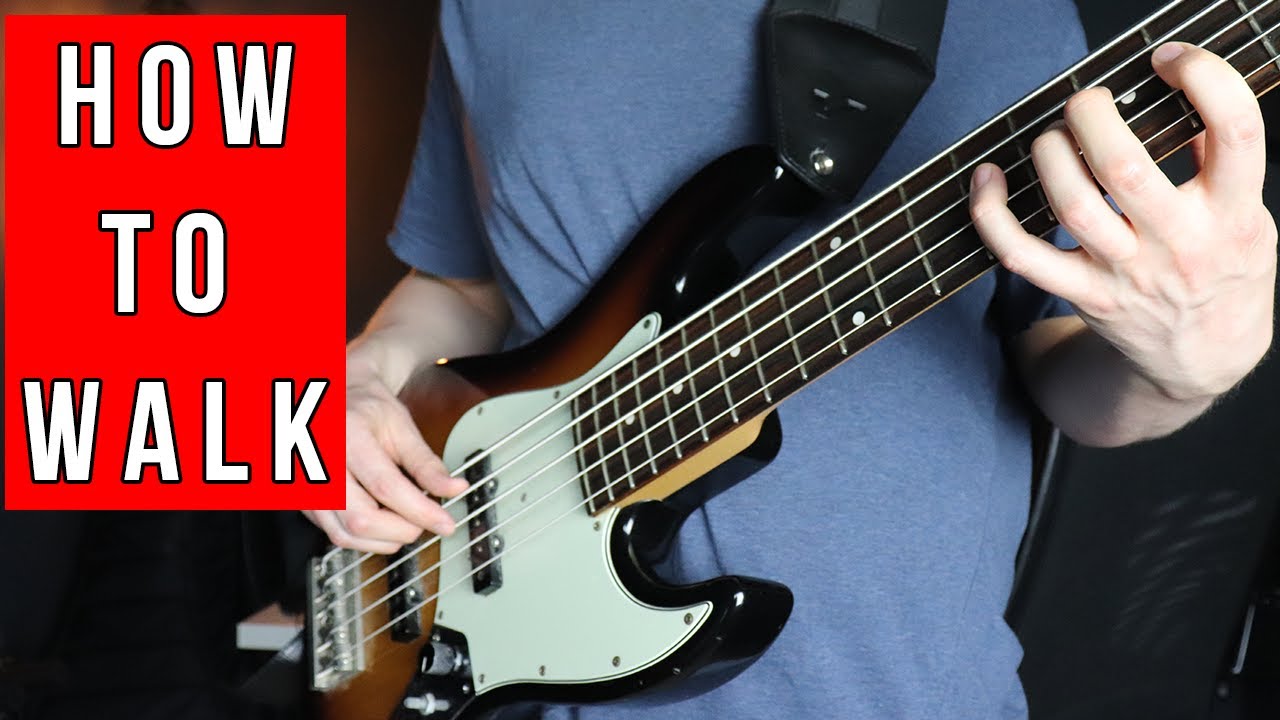What is a walking bass? In its simplest form, it’s a bass line that “walks” up and down the scale. It’s a common technique used in jazz, blues and other styles of music.
In this guide, we’ll teach you how to play walking bass lines and explain the theory behind them. We’ll also give you some tips on how to incorporate walking bass into your own music!
What is a walking bassline?
In music, a bassline is a term used for the lowest part in a piece of music, especially when it is played by an instrument such as the bass guitar or double bass.
A walking bassline is a type of bassline that uses a series of quarter notes, which gives it a smooth, flowing sound.
Or this is the walking bass music definition you’ll find in most music textbooks at least.
Walking basslines are often used in jazz and blues songs, and they can add a lot of energy and excitement to a piece of music. However, you do find something similar to them in classical music through figured bass.
When creating a walking bassline, the musician will usually start with the root note of the chord that they are playing, and then they will walk up or down the scale to the next chord.
This type of bassline can be very effective at creating a sense of forward motion in a piece of music, and it can also help to fill out the sound of a song.
Typically, they are either improvised or based around a repeating pattern or riff.
A good walking bass line example is “Killer Joe” by Benny Golson.
Playing Roots
As any bass player knows, the key to playing a great walking bass is understanding how important it is to play the root notes on the downbeat of a new chord.
Root notes are the foundation of the chord, and they provide the harmony and melody with a clear sense of musical stability.
Without root notes, the bass line would be aimless and directionless and it wouldn’t give us a very clear sense of what the harmony is.
The job of a walking bass player is to provide time and also outline the chord changes. And since the root note is the harmonic foundation of a chord, it’s simply non-negotiable. It must be played!
That’s why, when learning how to play walking bass, it’s important to focus on playing the root notes.
Once you have a solid understanding of how important the root notes are, you can begin to add in other notes and embellishments.
But always remember: the foundation of a great walking bass line is the root note. Play it well and everything else will fall into place.
Chords
Chord arpeggios are a powerful tool for creating walking bass lines.
By outlining the harmony of a chord, they can add movement and interest to the bassline while still remaining grounded.
When used tastefully, chord arpeggios can add a lot of tension and release to a bassline, making it more emotionally engaging.
They can also be used to add rhythmic interest or to emphasize the tonic note of a chord.
However, it’s important to use them sparingly, as too much arpeggiation can make a bassline sound cluttered and busy.
When used in walking bass lines, chord arpeggios can be a powerful tool for adding interest and movement to the harmony.
Target notes
A target note, as the name suggests, is a particular note within a bassline that the bassist will have the walking bassline move towards with a great sense of musical direction and purpose.
You’ve likely heard this concept in action before without realizing it.
Listen to what the bass player plays next time you hear a turnaround in a twelve-bar blues.
You’ll hear an ascending or descending chromatic line go down to the fifth of the scale and then back to the root.
In this case, the walking bass line target notes are the fifth and then the root.
But you can choose to make any note a target note as long as it works with the harmony you’re walking through.
Walking Bass Concept 1 – Root & Fifths
In music, the root is the main note of a chord, while the fifth is the note that is seven semitones above the root of the chord.
When constructing a walking bass line, it is common to use these two notes as the starting point.
The root provides a strong foundation for the chord, while the fifth adds power and tension. By using these two notes as a starting point, you can create a bass line that is both musical and supportive.
In addition, by varying the order in which you play these two notes, you can create interesting and complex bass lines that add variety to your playing.
Walking Bass Concept 2 – Approach Notes
The first step in creating a walking bass line is to identify the root notes of the chord progression. These notes will form the foundation of the bass line, so it is important to be precise when choosing them.
Once the root notes have been identified, the next step is to add approach notes. Approach notes are simply non-chord tones that lead into a chord tone. For example, if the root note of a C major chord is C, then an approach note could be B or D.
The purpose of using approach notes is to create forward momentum in the bass line and to add harmonic interest.
When using approach notes, it is important to choose notes that complement the chord progression and that resolve smoothly into the target note.
By carefully crafting a bass line with approach notes, you can create a walking bass line that is both musical and interesting.
Walking Bass Concept 3 – Chromatic Passing Tones
Chromatic passing tones are a common element in walking bass lines. As the name implies, these tones “pass” between the notes of the chord, creating a sense of forward motion.
They can be played on either beat of the measure, and they can occur between any two notes in the scale.
When used tastefully, chromatic passing tones can add a great deal of interest to a bass line.
However, it’s important to avoid overusing them, as they can quickly become muddy and difficult to follow. When used sparingly, chromatic passing tones can be a powerful tool for creating an engaging bass line.
Walking Bass Line Pattern
There are various ways that you can create a walking bass line. One common method is to use quarter notes.
This means that you will play four notes for every beat. Another option is to use eighth notes, which means that you will play two notes for every beat. You can also use a combination of both quarter and eighth notes. Experiment with different combinations to see what sounds best.
You could also think about incorporating common patterns of notes.
Many of the best walking bass players will do this for particularly common chord progressions such as ii-V-I’s and turnaround phrases at the end of a musical form like a jazz blues.
If you’re unsure of how to use a common pattern or piece of walking bass “vocabulary”, the best thing you can do is to transcribe a great bass player walking through a song that you know.
Great bassists to start with are Ron Carter, Charles Mingus and Ray Brown.
Final thoughts
A walking bass line is a type of bassline that is often used in jazz, blues and other styles of music.
It is created by using root notes, approach notes, chromatic passing tones and various patterns.
A walking bass line pattern can be quarter notes or eighth notes. You could also use a combination of both.
The best way to create a walking bass line is to experiment with different combinations until you find what sounds best.
FAQ’s
Why is it called a walking bassline?
Because the rhythm is either a steady stream of quarter or eight notes which is delivered with a steady pulse. When played well, this constant stream of steady notes imitates the constant and steady rhythm of walking feet. Hence the term walking bass.
How do you play walking bassline?
Walking basslines are a staple of jazz and blues music, and they can add a lot of rhythmic interest to a song.
There are many different ways to play a walking bassline, but the most important thing is to keep the rhythm moving.
The best way to do this is to use eighth notes, with each note falling on the beat. When playing a walking bassline, it’s also important to pay attention to the chord changes in the song.
As the chords change, so should the notes in the bassline. By following these simple guidelines, you can start adding walking basslines to your repertoire today.
How does a walking bass work?
By using a mixture of scales, arpeggios and passing tones to outline the chords of a song over a period of time.
What makes a walking bassline?
In music, the term “walking bassline” is used to describe a style of bass playing that uses a continuous series of quarter notes.
This approach contrasted with earlier styles of bass playing, which tended to be more sparse and only occasionally included sustained notes.
The walking bassline became a staple of jazz and blues music, helping to create a more consistent groove and allowing the drummer and other musicians to better lay down a solid foundation.
When constructing a walking bassline, musicians will often start by choosing a root note, which serves as the foundation of the line. From there, they will choose notes that move up or down in scale degrees, creating a step-wise motion.
These notes can be played in any order, but they typically follow some sort of pattern. For example, a common pattern is to move up two scale degrees, then down one scale degree, then up two scale degrees again.
What is a walking bass line what are its functions in jazz?
A walking bass line is a type of bass line used in jazz and other styles of music. The term “walking” refers to the even, rhythmical flow of the bass notes.
Walking bass lines are usually made up of eighth notes, or sometimes sixteenth notes.
The most important function of a walking bass line is to provide a steady pulse or beat for the other instruments to follow.
In addition, walking bass lines often outline the harmonies being played by the other instruments, making them an essential part of the rhythm section.
Without a walking bass line, many jazz tunes would sound unfinished or directionless.
So, if you’re ever feeling lost in a jazz tune, just listen for the walking bass line – it will always be there to be the foundation of the song.
How do I practice writing bass lines?
There are a few different approaches you can take when writing a bass line. One method is to come up with a simple bass pattern and then fill in the harmonic notes around it.
Another approach is to start with a chord progression, and then add a bass line that outlines the chords.
Regardless of which method you choose, the key is to keep it simple. The bass line should complement the other parts of the song, without overshadowing them.


Leave a Reply